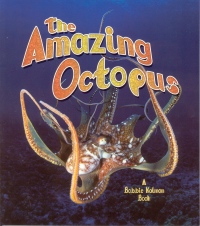| ________________
CM . . .
. Volume XI Number 8 . . . . December 10, 2004
excerpt: Extra-salty water - All oceans are saline, or contain salt, but sea ice makes polar oceans even more saline. When salt water freezes, only the water becomes ice. Salt does not freeze. Instead, it remains in the unfrozen water below the ice. As a result, the water has more salt. Because it contains more salt, the water in polar oceans is denser, or thicker and heavier, than that found in other oceans. It is much denser than air or fresh water. The denser water is, the more difficult it is to move through it, but objects can float on it more easily. For example, huge chunks of ice float on the polar oceans because the water supports them. (From Polar Oceans.) The four books that comprise Crabtree's "The Living Ocean" series cover the topic beginning with general information before narrowing it to more specific subjects. Each book contains a Table of Contents, Glossary and a brief Index. The first book, The Ocean Biome, gives an overview of this water-based environment that is the largest area on the planet. It discusses how various forms of marine life are adapted to exist in oceans and defines the six zones identified by scientists in ocean studies. Each zone is examined in greater detail, providing a clear idea of location, inhabitants and special features. All marine plants and animals are shown as an integral part of food chains and food webs. The book briefly discusses currents and the oceans' effects on climate. A page is devoted to the changes that have resulted from human activities in and around the oceans, with final descriptions of measures being taken to learn more about protecting this vital aquatic biome. Polar Oceans narrows the focus to the Arctic and Southern Oceans located at the Earth's poles. Distinctive characteristics of these oceans include sea ice, ice shelves, ice bergs and polynyas, or patches of open water. The book examines living things found near the surface (krill) and on the dark bottom of polar oceans. Various species of fish, animals and birds that exist on and under the ice are introduced briefly, as are the species such as whales that spend part of their life in polar oceans. One excellent feature in this book is the double-page spreads of the food web drawn as cutaways of the both oceans, a graphic way of highlighting the differences between these two environments. For example, the apex predators (top of the food chain) in the Arctic Ocean include polar bears hunting out of the water, whereas Southern Ocean apex predators (orcas and leopard seals) are a threat only under water. The young reader will clearly see that penguins only inhabit Southern Oceans. Problems facing polar oceans are given double space in this book: global warming may be responsible for increased ice melt, and pollution from around the world impacts on polar environments as well. As in the previous book, the final page is devoted to future trends in protecting these oceans, with websites to check for further information. The remaining two books in this series each highlight a specific species of ocean dweller, presenting an up-close study of the shark and the octopus. Through the use of high quality photos and drawings, fascinating features of these creatures are revealed. In Spectacular Sharks, a double-page spread on sharks' teeth and how they work will capture the attention of curious youngsters. Shark attacks are demystified as far as possible with a balanced and up-to-date view of reasons they occur. An insert describes warning signs given by one species of imminent attack. The book details the important role sharks play in their ecosystem and how they are threatened. The octopus receives equally intensive treatment in The Amazing Octopus. Of 250 known species of these 8-armed mollusks , the familiar common octopus is used to illustrate body parts common to all. Unusual features are described and well illustrated: octopuses have horizontal pupils lined up with the ocean floor, great senses of sight, touch, smell and taste and the chameleon-like ability to change color. Other defence strategies are detailed, as well as the superior intelligence of these creatures that are near the top of the food chain. Their role in balancing life in their ecosystems emphasizes respect for these curious animals, octopus-human encounters are described and threats to its existence outlined. All four books are generously illustrated with attractive layouts that young readers will enjoy exploring. Extra details are used for photo captions, and inserts add interest. Words in bold type are either clearly defined within the context on the page or listed in the Glossary on the back page. This series will make a useful, up-to-date addition to any library's science collection. Recommended - Highly Recommended. Gillian Richardson, who lives in BC, is a former teacher-librarian, freelance writer and writing instructor.
To comment
on this title or this review, send mail to cm@umanitoba.ca.
Copyright © the Manitoba Library Association. Reproduction for personal
use is permitted only if this copyright notice is maintained. Any
other reproduction is prohibited without permission.
NEXT REVIEW |TABLE OF CONTENTS FOR THIS ISSUE
- December 10, 2004.
AUTHORS
| TITLES | MEDIA REVIEWS
| PROFILES
| BACK ISSUES
| SEARCH | CMARCHIVE
| HOME |



